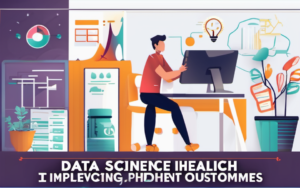Data analytics has become an indispensable tool in today’s data-driven world, shaping decisions across industries. But to fully appreciate its impact, we must delve into its origins and understand the journey it has taken. From humble beginnings, data analytics has evolved dramatically, driven by technological advancements and the increasing availability of information. Let’s embark on a historical journey to explore the fascinating evolution of data analytics.
The Dawn of Data Analysis: A Look Back at the Early Days
The roots of data analysis can be traced back to ancient civilizations, where people used rudimentary methods to collect and interpret data. Early societies relied on counting and measurement to track populations, trade, and agricultural yields. For instance, ancient Egyptians used hieroglyphics to record census data, while the Babylonians developed sophisticated mathematical techniques for astronomical calculations.
From Manual Calculations to Early Computing Power
The dawn of the modern era brought about significant advancements in data analysis. During the 17th and 18th centuries, scientists like William Petty and John Graunt pioneered the use of statistics to analyze social and economic trends. The development of the scientific method further spurred the use of data analysis in research. The invention of the mechanical calculator in the 19th century simplified complex calculations, paving the way for more sophisticated data analysis techniques.
The Birth of Statistical Methods and Their Impact
The early 20th century witnessed the emergence of modern statistical methods. Researchers like Karl Pearson and Ronald Fisher developed groundbreaking statistical techniques that revolutionized the way data was analyzed. These methods, including hypothesis testing, regression analysis, and correlation analysis, enabled researchers to draw meaningful conclusions from data, leading to advancements in fields like medicine, genetics, and social science. The development of statistical software packages further democratized data analysis, making it accessible to a wider audience.
The Rise of Data Warehousing and Business Intelligence
The 1970s and 1980s saw the emergence of data warehousing and business intelligence, transforming how businesses used data to make informed decisions. The rise of relational databases and data warehousing provided a structured way to store and manage vast amounts of information.
The Emergence of Relational Databases and Data Warehouses
Relational databases, pioneered by Edgar F. Codd, provided a standardized way to store and retrieve data, enabling businesses to analyze data across multiple departments and systems. The concept of data warehousing, introduced in the 1980s, further enhanced the ability to store and integrate data from various sources, creating a central repository for analysis.
The Power of Business Intelligence Tools and Dashboards
Business intelligence (BI) tools emerged to help businesses analyze data stored in data warehouses. These tools, such as reporting and dashboard software, provided visual representations of key performance indicators (KPIs) and trends, empowering managers to make data-driven decisions. The emergence of BI tools marked a significant shift towards a more proactive and data-driven approach to business management.
The Data Analytics Revolution: The Impact of Big Data and Cloud Computing
The late 20th and early 21st centuries witnessed a data explosion, driven by the rise of the internet, social media, and mobile devices. This influx of data, often referred to as “big data”, presented both challenges and opportunities for data analytics.
The Explosion of Data and the Need for Scalable Solutions
The sheer volume and velocity of data generated by modern businesses and organizations required scalable solutions. Traditional data analysis methods, designed for smaller datasets, proved inadequate for handling the massive amounts of data being generated. This led to the development of new technologies and frameworks for storing, processing, and analyzing big data.
The Rise of Cloud Computing and its Role in Data Analytics
Cloud computing played a crucial role in enabling the widespread adoption of data analytics. Cloud-based platforms offered scalable storage and processing power, making data analytics accessible to businesses of all sizes. The ability to access computing resources on demand, without the need for significant upfront investments, further accelerated the adoption of data analytics solutions.
The Future of Data Analytics: Trends and Predictions
Data analytics continues to evolve at a rapid pace, driven by advancements in artificial intelligence (AI), machine learning (ML), and cloud computing. The future of data analytics holds exciting possibilities, with new technologies and approaches emerging to unlock the full potential of data.
The Growing Importance of Artificial Intelligence and Machine Learning
AI and ML are revolutionizing data analytics by automating complex tasks and enabling more sophisticated analysis. Machine learning algorithms can identify patterns and trends in data that would be difficult or impossible for humans to detect. This allows for more accurate predictions, improved decision-making, and the development of innovative applications in various fields.
The Rise of Data Democratization and Citizen Data Scientists
Data democratization is another key trend, making data analytics accessible to a wider range of users. The rise of citizen data scientists, individuals with limited technical expertise but strong analytical skills, is enabling businesses to leverage data analysis capabilities across various departments. User-friendly tools and platforms are making data analysis more accessible, allowing individuals to explore data, generate insights, and contribute to data-driven decision-making.
The Ethical Considerations of Data Analytics in the Future
As data analytics becomes increasingly powerful, it’s crucial to address ethical considerations. The use of data for decision-making raises questions about data privacy, bias, and transparency. It is essential to develop ethical guidelines and frameworks to ensure responsible and ethical use of data analytics, promoting fairness, accountability, and respect for individual privacy.
The journey of data analytics has been marked by innovation and transformative breakthroughs. From its humble beginnings to the era of big data and AI, data analytics has evolved into a powerful tool that shapes our understanding of the world and drives progress across industries. As we move forward, the future of data analytics promises to be even more exciting, with new technologies and applications continuing to emerge, unlocking the full potential of data for good.




